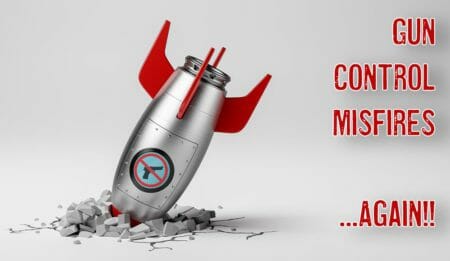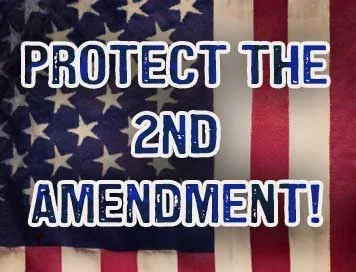Why the Firearms Control Act Failed – In South Africa
By Frans Cronje
The South African Institute of Race Relations
This is a great third party look at how gun control has failed in South Africa, many of the tactics and mantra’s of the US Gun Control groups, particularly: Laws based on Ideology, Control Of Guns Means Less Crime are shown to fail miserably in this relatively free country. – Fredy Editor @ Ammoland

South Africa –-(Ammoland.com)- >Research and Policy Brief: Why the Firearms Control Act failed and what should be done about it – 21st June 2011.
In 2004 the South African Government implemented new gun control legislation in the Firearms Control Act.
The Act required licensed firearms owners in the country to relicense their weapons over a period of five years.
The legislation was billed by the Government as a response to South Africa’s high violent crime levels. It was widely hailed by South Africa’s anti-gun lobby and even endorsed by the respected Institute for Security Studies. However, five years down the line the Government has been forced to admit that its efforts in relicensing legal guns have been beset by backlogs, delays, and disorder.
Despite media coverage to the contrary the 2004 legislation was not significantly more thorough in assessing the good standing of a prospective firearm owner than the Arms and Ammunition Act (1969) it replaced. Under the new Act a person had to pass a criminal background check, motivate the need for their weapon, have adequate safe-keeping facilities, pass a basic shooting test, write a theoretical test, and present three family members/acquaintances as character references. The old Act differed mainly in that it did not prescribe the basic shooting test and theoretical exam – both of which were set at such a pedestrian standard that they could easily passed by a child after 20 minutes of instruction.
The real difference in policy came in the fact that the new legislation required all the estimated three million licensed gun owners in South Africa to renew the licenses for their estimated 4.5 million guns within five years and then every 5 – 10 years thereafter.
A second policy change was that the police doubled much of their workload in requiring legal firearms owners to follow a two-step process of first applying for a certificate of competence for the firearm they wished to licence and then for a licence for the firearm itself. As things have turned out this has proved to be an administrative burden too far.
Significant backlogs developed very early on in the process despite the fact that only a relatively small number of the estimated 3 million legal gun owners in the country subjected themselves to the process. In fact data at hand suggests that only 1.4 million relicensing applications have been received to date. What happened to the possibly three million other previously legally held guns in South Africa is unclear.
It is possible that the law has led to a situation where over a million South Africans are now liable for arrest and prison sentences of up to 15 years – an untenable situation.
The backlogs stand in strong contrast to sentiment in the police in 2004 when Superintendent Andrew Lesch said, “The SAPS have been preparing for the implementation of the Firearms Control Act and regulations and I am convinced that we are able and ready to implement the Act”.
He added that preparation included the establishment of a structure for designated firearms officers, the appointment and training of these officers, and equipping them with the resources to deal with all aspects relating to the licensing of firearms.
In 2010 after many complaints the new Zuma administration, to its credit, conducted an assessment of the implementation of the new law. The findings led to a refreshingly honest assessment by senior police management that corruption and ineptitude had led to the failed implementation of the law. In some cases applicants had been waiting for more than five years to have their applications finalised.
The problems identified in the police’s assessment were, however, the same as those forecast by professional shooting and hunting organizations in the run-up to the introduction of the Act in 2004. They warned that the police did not have the capacity to carry such an onerous administrative burden. Their warnings were ignored, even scoffed at, by the proponents of the legislation.
However quite why the legislation degenerated into a shambles is not immediately clear. In terms of simple administration relicensing guns that already belonged to licensed owners should not have been substantially more cumbersome than that of issuing identity documents or renewing driving or motor vehicle licenses. A police criminal record check should not take more than a week to complete, interviewing three character references should take only minutes, and completing a safe inspection should take only an hour. In fact more than 8 million motor vehicles are relicensed annually without too much trouble. Yet the police’s bureaucracy has been thrown into chaos after receiving just 1.4 million relicensing applications over 5 years. One can only imagine what would have occurred had they received relicensing applications for the estimated 4.5 million legally held guns in circulation. It is unclear exactly how much money was invested in the Act but it was at least several billion rand. Resource shortages can therefore not be an adequate explanation for the stuttering administration of the law. To an extent laziness and ineptitude, cumbersome paperwork, and very complicated bureaucratic structures combined to seize the process. But these are features of all government bureaucracy and are not sufficient explanations of why the Act failed.
What more than anything distinguished this piece of legislation from that, for example, regulating the renewal of motor vehicle licences is that it was conceived at the outset to be hard to comply with.
It was a law designed after all to make it difficult to legally own a firearms.
Had the law been made to be fair, and just, and reasonable to comply with it might have won the backing of the shooting community in South Africa. However it was from the outset accompanied by threats of prison sentences and the like, creating the impression that every legal hunter and sports shooter in the country was just a step away from being a dangerous felon. Also, the police stubbornly refused to release any guidelines against which they would judge the motivations people gave for requiring a firearm. The proponents of the law may have hoped that the very bureaucratic delays we have seen would themselves serve as disincentives to own a firearm – disarmament via bureaucratic malaise. But, as we have also seen, relatively few legal firearms owners subjected themselves to the stuttering police bureaucracy and so the hope of better regulating firearms in legal hands was defeated. What the drafters clearly had not counted on was that making the law difficult to comply with would make it difficult to implement and therefore to enforce.
A Law Based On An Ideology Not On Reason & Logic
A second point that distinguished this law from (some) others it that is was based more on an ideology than on reason and logic. The ideology prevalent among proponents of the law was very simply that firearms in private hands ‘caused’ crime and that private gun owners therefore needed to be disarmed.
This sentiment is spurious. Not all armed societies demonstrate high levels of violent crime. In some cases quite the opposite has been true. In South Africa’s case the police did not even keep complete records about what kinds of guns and their origins were used in what kinds of crimes. We have never known, for example, to what extent firearms owned by the police and the military are used in house robberies compared to weapons illegally imported from Mozambique – let alone legally owned hunting rifles. Nor was there any certainty about the actual number of licensed firearms owners in the country or the actual number of licensed guns. The cited figures of three million licensed gun owners were at best an estimate based on unsatisfactory police records. As for unlicensed guns and their owners, no reliable data exists. There is also no complete information on incidents where licensed gun owners used guns to protect themselves or other people from criminals. A further point is that mortality data in South Africa does not distinguish between a homeowner shot dead by a robber and a robber shot dead by a homeowner.
Yet despite these significant shortcomings in our knowledge the Government set about introducing the relicensing process. This makes the case that the legislation can only have been motivated on ideological grounds. In fact the proponents of the law had a very easy task. In place of solid policy research they only had to interview a few recent victims of a horrible crime, or a dedicated but overworked doctor in an emergency room, and they had all the evidence they needed that guns caused suffering and anguish and that legal gun ownership had to be restricted. They substituted fear and emotion for actual evidence and the result was a process that has led to records and controls that tell us less about how many guns are legally in circulation in the country than at any point since the end of the Second World War.
This also set a precedent for both law making and the rule of law in South Africa in the sense that ideology was allowed to trump facts in driving the law making process. The Firearms Control Act has therefore set a precedent for laws that may come to restrict property rights ‘because the willing buyer willing seller model does not work’ and laws that restrict media freedom and access to information ‘because of threats to state security’.
The law’s effect on lowering the levels of violent crime, its stated aim, has been inconclusive at the very best. In July 2004 Bua News quoted the then safety and security Charles Nqakula as saying that South Africa was “sick and tired of … serious violent crimes committed with firearms, and the Government, through this legislation, has adopted a constructive approach to address this problem”.
While the number of murders fell by 18% in the five years since the law was enacted, it had already fallen by an even greater 25% in the five years preceding its implementation. The total number of armed robberies (committed with all weapons, not just guns) saw a slight decline over the past five years. However, those armed robberies most likely to be perpetrated with guns, such as house and businesses robberies, increased by over 100%. The number of car hijackings, committed almost exclusively with guns, saw a slight increase. In fact the evidence can easily be used to argue that we are at greater risk of being victims of gun crime than before the Act.
So there is rather little to show for the five years of effort and billions of rand ploughed into South Africa’s gun control laws. However, following the police’s 2010 enquiry, the minister of police has pledged that all backlogs will be resolved before the end of 2011. This is a bold commitment, especially as the minister has at the same time added significantly to the already gridlocked administrative burden in now requiring the police to issue competency certificates for the hundreds of thousands of owners of antique guns in South Africa within the next 12 months. These flintlock and similar pistols and muskets, many of which last saw action with Wellington and Napoleon at Waterloo, will now see their owners have to comply with much of the same competency process that applies to the owners of modern weapons. Quite what the point of this is is unclear – other than the police saying they are dangerous.
What is equally unclear is what is going to happen about the possibly 3 million once legally held weapons whose owners have not complied with the law?
The police’s threats to arrest all these errant individuals will be meaningless as their arrest and conviction would necessarily amount to a tenfold increase in South Africa’s total prison population!
For this and other reasons we remain sceptical that the legislation will ever be workable until the underlying ideological flaws in its conception are addressed. As long as the law remains unworkable South Africa will not have an effective mechanism to regulate the flow of legally held firearms in the country – a real security threat. Addressing the flaws in the law’s conception will in effect require rewriting it to win the backing of the law abiding shooting community in the country who also fear violent crime but who realise the idiocy of a law that treats a Napoleonic musket, a Boer War Martini Henry, and a modern assault rifle in largely the same way.
Rewriting the law would itself be premature until we understand more about the relationship between privately held firearms and crime in South Africa. What is necessary is first an audit of all privately held firearms in the country. Secondly the police should capture a complete database of the types and origins of weapons used in crimes in South Africa. Thirdly research should be conducted on the prevalence with which privately held weapons are used in defence of life and property.
Fourthly specific research needs to be conducted on the relative impact of handguns as opposed to ‘long’ hunting and sporting guns in our society – especially the economic impact of the hunting industry.
Then, and only then, will we have the knowledge we require to make fair, reasonable, logical, and purposeful legislation regarding the private ownership of the guns in South Africa.
About South African Institute of Race Relations:
The Institute is an independent think-tank producing research, policy critiques, and risk analysis on South Africa. Our fields of expertise include the economy, business, labour, education, demographics, living conditions, crime, security, healthcare, land reform, service delivery, politics, and government affairs. We benchmark ourselves on telling our subscribers today what they will read in the media in two or three years’ time. Visit: www.sairr.org.za







In terms of simple administration relicensing guns that already belonged to licensed owners should not have been substantially more cumbersome than that of issuing identity documents or renewing driving or motor vehicle licenses. You err. Identity documents – this has failed – There is no reason as to why a drivers licence should not be acceptable as an identity document, indeed it was previously part of the id. Yet it is not. There is no reason as to why South AFricans should have to have Visas to visit England, Australia etc, we have to because the passport identity document failed.… Read more »
Exactly the same thing has happened to the Canadian firearms farce! Both the S.A. system and The Canadian System were advided championed by the same anti gun person, one Ms Wendy Cukier. Canada is in the process of dismantling their 'gun farce'. SA should be doing the same.. Never Anywhere in the history of the entire world, has the licensing and registration of legally obtained firearms resulted in a lower crime rate. It usually just increases the crime rate, because most of the criminal now know that their is a much better chance of their victim being defenseless.. Call it… Read more »